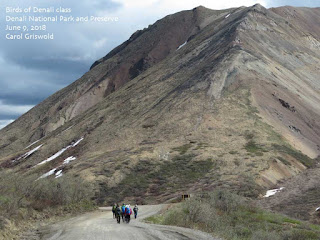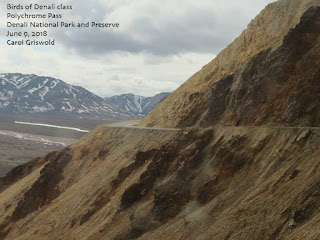Traveling from Seward, Alaska to Denali!
On Thursday, I tore myself away from the mirror-calm waters just off-shore on Resurrection Bay where a Humpback Whale lunge fed with her calf nearby (wow!) and drove to Anchorage. The next morning, my daughter and I boarded the Alaska Railroad Denali Star train for our weekend "Birds of Denali" class in Denali National Park and Preserve.
Of note along the way: just north of Wasilla, an OSPREY nest on an artificial platform next to the power lines. One bird was in the nest, the other perched on the power line like a giant Kingfisher. At the Talkeetna stop, an OLIVE-SIDED FLYCATCHER called, “Quick! Three beers!” Also heard a FOX SPARROW, and NORTHERN WATERTHRUSH. Farther north at another stop to swap staff with a south-bound train, I heard more NORTHERN WATERTHRUSHES singing from the brushy wetland along the tracks.
Also of interest, historic WAMCAT telegraph poles from the early 1900s, many with their original glass insulators intact. It is amazing they are still standing after all these years! The train rumbled across rust-red steel trestle bridges, and the Hurricane Gulch bridge, built in 1921, an engineering marvel spanning an impressive gorge more than 900 feet across and 300 feet deep.
We arrived around 4 pm in time to check out the displays at the visitor center, and then headed over to the class headquarters at the Murie Science and Learning Center. After introductions and orientation, we loaded up into the van and headed to the Teklanika field camp at Mile 29 of the Park Road. Along the way, we saw several WILLOW PTARMIGAN by the road, still mostly white, changing into their summer plumage. After unloading our gear into one of five wall tents, we took our first field trip to the river outwash plain. Though it was overcast and almost 9:30 pm, it did not seem late as it was so light.
Naturalist and instructor Maria Berger led the group, sharing her extensive knowledge of birds, wildlife, flowers, trees, lichens, mosses, etc, geology and archaeology. Able guide, driver, cook, organizer, and safety officer Morgan made sure no one got left behind.
Birds heard and/or seen: MEW GULLS, GRAY JAY, BLACK-BILLED MAGPIE, COMMON RAVEN, SWAINSON’S THRUSH, HERMIT THRUSH, AMERICAN ROBIN, VARIED THRUSH, YELLOW-RUMPED WARBLER, and WHITE-CROWNED SPARROW.
Snowshoe hares changing from winter white to brown loped through the underbrush; their population is approaching a cycle high as evidenced by many gnawed branches and tree trunks. Katie found a sweet little bird’s nest (sparrow?) made of grasses and moose hairs with a loose ball of the same on top, tucked at the base of a small willow; no bird was found. We found caribou and moose tracks and their respective scat in the dried mud, and old wolf scat.
On the way back through the campground at 11:15 pm (still light!) Katie noticed a dead bird pinned to the front of an RV grill. Poor thing! It was a White-crowned Sparrow, probably flying across the road to get food for its babies. I pried it off for educational purposes: note the black and white head stripes like a bicycle helmet, the stout yellowish sparrow beak, and strong legs and long toes for scratching leaves aside to find invertebrates, then laid it in a spruce branch to return to Nature's web of life.
We climbed into our sleeping bags around midnight for a chilly night (at least for me) as temperatures dropped to the low 40s and dampness penetrated the canvas tents.
We were up and at ’em Saturday morning at 7 am for breakfast, packed and on the road by 9. All around, ominous dark clouds hugged the spectacular mountain scenery, but we seemed to be in a sunny oasis. More Willow Ptarmigan and snowshoe hares were spotted along the road. We got out for a look and listen along the road in a willow- cottonwood successional habitat bordering a creek and found WILSON’S and YELLOW-RUMPED warblers singing and disputing territories, and a weathered domed Magpie nest from last year. We were hoping for an Arctic Warbler, but no luck.
We drove to our hiking destination by Cathedral Mountain and parked. As we walked back to the social trail etched into the landscape, we saw and heard an AMERICAN TREE SPARROW in the willows. Descending from the road we encountered a swift, cold creek that entailed a stream crossing. A variety of methods failed to keep us dry, but all survived the exciting crossing and soon got warm again as we gained altitude up the ridge. I saw a white butterfly that seemed large enough to be a male Phoebus Parnassian, but it was too far away to photograph. So many beautiful, tough, alpine flowers clung to this harsh landscape, including a special Beringia endemic, Saxifraga escholtzii, a tiny cushion plant with yellow flowers.
At the top of a ridge, we enjoyed lunch and a spectacular view of Cathedral Mountain. Far across the valley, a ROCK PTARMIGAN in white winter plumage stood on a rocky outcrop. We were amazed to see it effortlessly run uphill. High above, a GOLDEN EAGLE flew upwards then soared down, rose up, soared down, as if on an invisible roller coaster. Wheeeee! Behind us, a nursing Ground Squirrel stood alert at her burrow, watching us and all, understandably nervous about being such an integral part of the food web.
All too soon, we headed back down another route through a dwarf birch forest sprinkled with Lapland Rosebay shrubs in full bloom. Tealeaf Willows were also in full bloom, the male flowers bright red with yellow pollen splitting open. We slid down a short snow slide, crossed the stream (same results), and headed back up to the van.
On our way to Polychrome Pass, we stopped to watch a RAVEN’S nest built on the overhanging buttress of a bridge. Countless busses and heavy road machinery rumbled past this nest, likely not aware of the little family so close by. Five large Raven babies sat in the nest; one lay facing the bridge and seemed lifeless at first. They seemed close to fledging. One parent flew past, searching high and low for something to feed these bottomless pits. Finally, it seemed to find a piece of roadkill and spent some time ripping it into smaller pieces. Then it flew to the nest, quickly thrust it into the nearest excited babies’ squawking beaks and flew off to find more. We all breathed a sigh of relief when the fifth baby got in the action. We wondered where the other parent was, as usually both attend the nest. It’s a big job for just one parent.
With all the traffic, it is likely that road-side scavenging for flattened ground squirrels and birds is quite productive. A recent, nearby bear kill might also provide ample food though we saw no evidence of that bounty.
Polychrome Pass, the site of a massive early-spring landslide, is spectacular and thrilling. The narrow strip of road plunges into oblivion on the valley side and features many blind curves. I don’t know how private vehicles manage to survive without the extensive training required of all bus and van drivers. So glad I was not driving! (Yay, Morgan!)
The highlight of this stop was the GYRFALCON nest clinging to a steep cliff face. One gray-phase parent was poised at the edge of the giant former Golden Eagle nest, and soon flew off, leaving a heap of four or five adorable, white chicks. After a time, a few struggled to stand on their sturdy legs, looking like they wore insulated pants. It will be a long flight down when these guys finally fledge!
We did not see the adult Gyr again, and the babies waited quietly. A NORTHERN HARRIER flew past, looking for voles, ground squirrels, hares, or Ptarmigan. We also saw Dall Sheep in the distance.
On the way back, we saw a distant Brown Bear sow and large cub snoozing in the Toklat River outwash plain. They looked like large logs. After a time, mom got up and rummaged around, but overall, they seemed pretty laid back. Someone saw the cub nursing, through the spotting scope.
Back at camp, a BOREAL CHICKADEE parent frisked the spruce needles for spiders and insects to feed its fluttering, begging baby. SWAINSON’S THRUSHES called, a sound I had not heard before. Then we tracked down the highest note I have ever heard, a single-pitched, piercing sound, to the top of a spruce tree where a VARIED THRUSH opened its beak and this note sounded. Never heard THAT before either! So interesting!
To be continued!!!




























































No comments:
Post a Comment